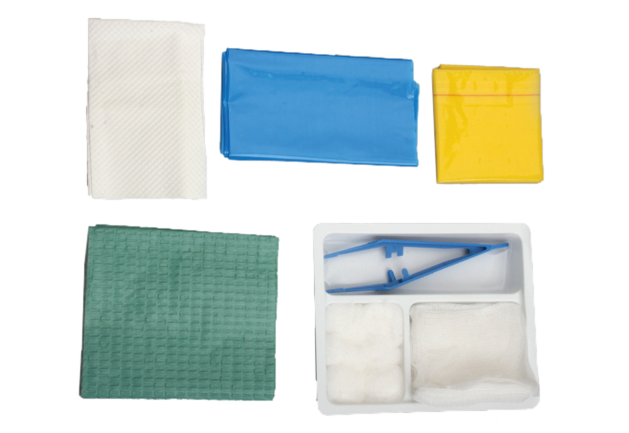
Basic Dressing Set
A basic dressing set is a collection of items that are used to clean and dress wounds.
1pc Gallipot tray with 3 compartments
6pcs Cotton wool balls 0.5gm
6pcs Gauze swabs, 13 thread, 7.5×7.5cm
1pc Dissecting forcep
1pc Waterproof drape
1pc Sterile field
1pc Hand towel
1pc Limpet bag
A basic dressing set is a collection of items that are used to clean and dress wounds. The set typically includes a sterile gauze pad, adhesive bandage, antiseptic wipes, and tape. It is important to have a basic dressing set on hand in case of minor cuts or scrapes. The first step in using a basic dressing set is to clean the wound. This can be done by using the antiseptic wipes to gently clean the area around the wound. Once the wound is clean, the gauze pad can be applied. The gauze pad will help to absorb any blood or fluid that may be coming from the wound. Next, the adhesive bandage can be applied. The adhesive bandage will help to keep the gauze pad in place and will also provide some protection from further harm. Finally, the tape can be used to secure the dressing in place. It is important to change the dressing regularly, especially if it becomes wet or dirty. A basic dressing set can be a helpful tool in promoting healing and preventing further harm to a wound.
A basic dressing set helps to protect a wound from further harm and promote healing. The dressing covers the wound and keeps it clean, while the bandage helps to hold the dressing in place.
The functions of a basic dressing set are to:
- Protect the wound from further harm
- Apply pressure to the wound
- Promote healing by keeping the wound clean and moist
- Reduce pain and swelling
- Prevent infection
A dressing set is an essential tool for anyone who wants to protect a wound and promote healing. Here are some tips on how to use a dressing set:
1. Clean the wound. Use clean water and soap to remove any dirt or debris from the wound.
2. Apply the dressing. Place the dressing over the wound, making sure that it is secure.
3. Monitor the wound. Check the dressing regularly to make sure that it is still in place and that the wound is healing properly.
There are many types of dressings available on the market, each with different purposes. Here are some common types of dressings:
-Gauze: Gauze is a type of open weave fabric that is commonly used as a dressing. It is available in various sizes and can be used to cover small or large wounds.
-Bandages: Bandages are strips of material that can be used to hold a dressing in place. They are available in different widths and lengths to accommodate different sizes of wounds.
-Wound pads: Wound pads are absorbent dressings that are used to soak up blood and other fluids from the wound site. They are available in various sizes and shapes to fit different types of wounds.
-Tape: Tape is often used to secure dressings or bandages in place. It is available in different widths and lengths to accommodate different needs.